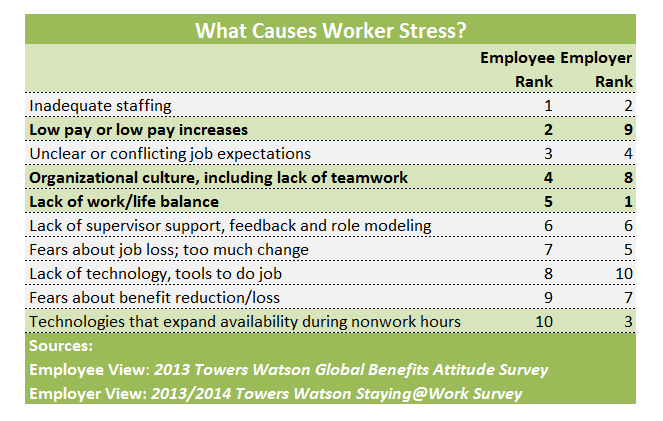

Employers know that their employees are stressed at work, and rank stress as the number one workforce risk issue, according to the 2013/2014 Towers Watson Staying@Work Survey, conducted by Towers Watson, and the National Business Group on Health.
But when Towers Watson compares employer views on the drivers of stress to employee rankings of their top stress drivers from a separate employee survey—the 2013 Towers Watson Global Benefits Attitude Survey of 5,070 U.S. workers (for companies with 1,000-plus workers)—the global professional services company finds evidence of a disconnect.

Employers rank the top three causes of workplace stress as lack of work/life balance (86 percent), inadequate staffing (70 percent) and technologies that expand employee availability during nonworking hours (63 percent).
Inadequate staffing includes lack of support or uneven workloads and performance in groups. Employees—like employers— rank this issue in the top three. In fact, the employees rank the issue as the number one source of stress.
Employees, however, rank low pay or low pay increases as the second biggest cause of their stress, while a tally of employer responses puts the pay issue in ninth place.
Based on 10 drivers of workforce stress, employees ranked lack of work/life balance fifth, while employers ranked it first.
In addition, while employers thought that after-hours connectivity from mobile devices was the third-most likely source of stress, employees ranked that at the bottom on the list.
“Employees seem to be saying, ‘support me, pay me, and direct me,’ but employers are focused on other stress factors,” said Shelly Wolff, senior health care consultant at Towers Watson.
“Stress has a strong link to physical health, emotional health, personal purpose and community—all contributing factors to workplace performance. Employers that fail to understand employees’ views on stress risk diverting time and resources to fixing the wrong problems and, at the same time, alienating employees,” said Wolff in a statement about the Staying@Work Survey of employers released last week.
In the view of employees, organizational culture ranked as the fourth cause of stress. This includes lack of teamwork, and the tendency to avoid accountability or assign blame to others.
The report on the Staying@Work Survey begins by noting that U.S. employers are concerned that lifestyle risks are widespread throughout their workforces. As a consequence, employee illness and medical costs are rising, and productivity is lost due to unplanned absence and decreased efficiency on the job.
Employers responding to the survey said that stress is the biggest lifestyle risk affecting the workplace (78 percent), followed by obesity (75 percent) and lack of physical activity (73 percent).
The report reviews employer views on employee well-being programs, employee participation, and the degree to which employers hold employees accountable for managing their health, in addition to providing the employer and employee rankings of stress drivers.
In addition, the statement reporting the results reviews solutions for establishing a workplace culture that proactively manages stress.
According to the media statement, employers report that in order to help employees manage stress, they:
But while employers feel that the employee assistance program (EAP) is a primary way to address stress issues, only 5 percent of employees say they use this resource. Also, only about four in 10 employers (39 percent) offer overt stress management interventions to employees (e.g., stress management workshops, yoga or tai chi). Employees turn to leisure/entertainment activities (47 percent), social support (42 percent) and physical activities (39 percent) to help them cope.
“Employers need to understand their employees’ stress drivers, assess their health and productivity programs in light of the findings and leverage what employees are already doing to cope with stress,” said Helen Darling, president of the National Business Group on Health. “Employers should improve and promote EAPs, encourage employees to take vacations, design company-sponsored physical activities and offer formal programs to effectively manage stress.”
In addition, organizations need to take a closer look at their EVP, including employee compensation, lack of adequate staffing levels, unclear or conflicting job expectations, and organizational culture. Improved manager training, clear direction on the job and a review of compensation practices could help alleviate the stressors.
Sources: Towers Watson, National Business Group on Health
The 2013/2014 Towers Watson Staying@Work Survey was completed between May and July 2013 in North America, Latin America, Europe and Asia by a total of 892 employers.
In the United States, Towers Watson and the National Business Group on Health jointly sponsored the survey. Of the 199 U.S. participants in the U.S., 59 percent are public; 22 percent are private, and 19 percent are nonprofit or government agencies.
The 2013 Towers Watson Global Benefits Attitude Survey (GBAS) was completed by 5,070 U.S. workers at companies with 1,000 employees or more.
The National Business Group on Health is the nation’s only nonprofit organization devoted exclusively to representing large employers’ perspective on national health policy issues and providing practical solutions to its members’ most important health care problems. The Business Group promotes ideas for controlling health care costs, improving patient safety and quality of care, and sharing best practices in health benefit management with senior benefit and HR professionals and medical directors from leading corporations. Business Group members, which include 66 Fortune 100 companies, provide health coverage for more than 50 million U.S. workers, retirees and their families. For more information, visit
Towers Watson is a global professional services company that helps organizations improve performance through effective people, risk and financial management. The company offers solutions in the areas of benefits, talent management, rewards, and risk and capital management.